
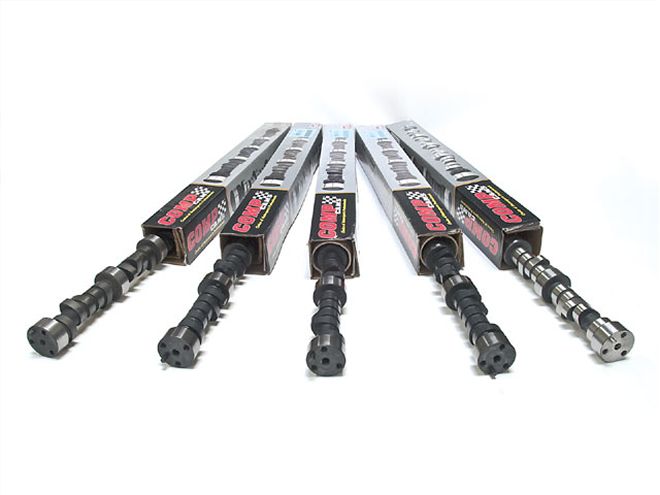 You buy, we try: Working with Westech Performance, HOT ROD tested Comp Cams' best-selling small-block Chevy cams-four hydraulic flat tappets and one of the new Thumpr-series hydraulic rollers. Read on to find out how well these cams perform and how far valvetrain technology has evolved.
You buy, we try: Working with Westech Performance, HOT ROD tested Comp Cams' best-selling small-block Chevy cams-four hydraulic flat tappets and one of the new Thumpr-series hydraulic rollers. Read on to find out how well these cams perform and how far valvetrain technology has evolved.
The camshaft is one of the most important factors in determining an engine's torque and powerbands, able to make or break an overall engine combination. On the street, hot rodders must tread a fine line in balancing performance improvement with overall driveability and reliability. For a variety of reasons-a proven track record, familiarity, word of mouth, or just plain tradition ("My Dad used that cam and it worked great."), hot rodders tend to stick with what worked well in the past. Although a major cam company like Comp Cams may offer dozens (if not hundreds) of potential cams for a particular engine family, a relatively small number of profiles accounts for the vast majority of sales. But how well do they actually perform in the average engine? To find out, Westech Performance recently put Comp Cams' five most popular small-block Chevrolet cams to the test on a 10:1 355ci small-block, a test engine the company calls Gladiator.
Cam vs. Cam
The cams' popularity rankings are based on Comp's sales figures for discrete part numbers for the past two years. The top five cams turned out to be four well-proven hydraulic flat-tappet cams-two Magnums and two Xtreme Energy profiles-plus one of the dynamite new Thumpr hydraulic-roller grinds that has been out for just over a year (see cam specs table).
These cams have the original-design cam nose that fits '55-'86 small-blocks. They require standard Chevy small-block timing chain sets and (with a roller cam) an antiwalk button. Westech's Gladiator is based on a late block with provisions for a factory cam thrust plate that mates with a different timing chain and cam nose. For these tests, Westech merely bolted on a standard-style chain. (If desired, an equivalent cam grind with the late nose can be ordered.)
In recent years the contamination of the parts chain with inferior, cut-rate, foreign-made flat-tappet lifters plus the removal of Zinc dialkyl-dithiophosphate (ZDP) additives from today's car and light-truck motor oils has raised some durability issues. Comp now offers its flat-tappet cams with an optional nitriding process that greatly increases lobe protection during initial run-in. For most grinds, this must be custom-ordered (use a generic custom-grind part number, plus a profile number; see table). A few selected profiles are now shelf stocked under a new, separate number (like the XE274H-10 tested here). Nitriding adds at least $110 to the cam's price, but it's great insurance if you can afford it.
Head vs. Head
Two cylinder heads representative of current small-block street-engine tech were used for this comparo: entry-level iron late-model GM Vortec cylinder heads (casting No. 906), as well as one of the best-flowing bolt-on aftermarket replacement aluminum street heads out there, the Air Flow Research (AFR) Street Eliminator 195.
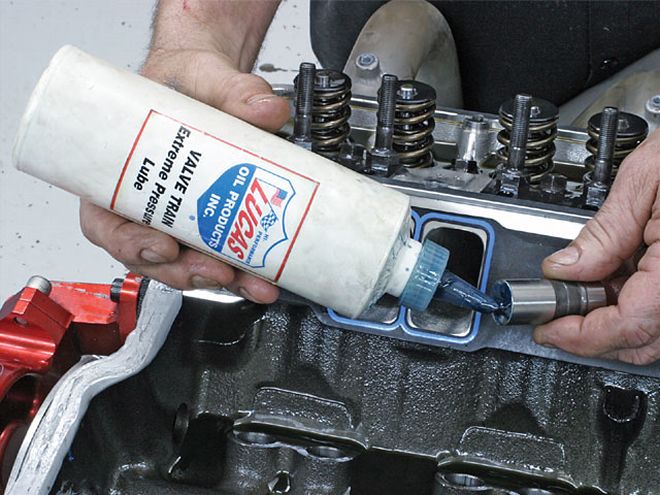 Minimize flat-tappet cam failure with a Comp-nitrided core. Then use only quality U.S.-made lifters, good break-in lubricant, and truck or race motor oils that retain high ZDP extreme-pressure additive levels. Westech relies on Lucas Oil TB Zinc-Plus break-in additive and 15W-40 Magnum High TB motor oil.
Minimize flat-tappet cam failure with a Comp-nitrided core. Then use only quality U.S.-made lifters, good break-in lubricant, and truck or race motor oils that retain high ZDP extreme-pressure additive levels. Westech relies on Lucas Oil TB Zinc-Plus break-in additive and 15W-40 Magnum High TB motor oil.
Vortec castings are the best iron heads ever installed by GM in a stock vehicle. Out of the box, they leave all earlier stock iron heads in the dust-including fuelie or camel-hump castings. GM says the Vortecs are consistently worth 20-40 hp over these earlier heads, as well as being unleaded fuel-compatible. GM installed Vortec heads on trucks, vans, and SUVs starting in 1996 through as late as 2001. GM dealers sell fully assembled heads at a very friendly price, and used assemblies can still be found in reasonable condition. On the other hand, stock Vortec heads have retainer-to-valveguide clearance issues, require a dedicated intake manifold and gasket combo, need self-aligning rockers, have pressed-in rocker studs (which didn't present a problem with our test cams), and are machined for late-style center-bolt valve covers that may not clear aftermarket roller rocker arms.
AFR's 195cc Street Eliminator head is a direct bolt-on for standard small-block Chevrolet heads. It has 195cc intake runners; a modern, heart-shaped 65cc or 75cc combustion chamber; and lightweight, 8mm-stem, 2.05/1.60-inch head valves that close against interlocking, ductile-iron valve seats, hardened to make them compatible with unleaded fuel.
Test Setup
Other parts used include Fel-Pro gaskets, ARP head and intake bolts, a 750-cfm Holley double-pumper carb with power-valve blowout protection, new Holley/Weiand Air Strike dual-plane intakes, and MSD ignition components. Two different-length Comp pushrods were used: one for the flat-tappet cams, the other for the single hydraulic roller cam (see parts list). All tests were conducted on Westech's SuperFlow 902 dyno running 91-octane unleaded gas supplied by Rockett Brand Racing Fuels. Westech dialed in 35 degrees of lead and rejetted the carb as needed to achieve the best BSFC numbers with each combo. All runs were made from 2,500 to 6,500 rpm. The results represent the average of the two best SAE J-607-corrected runs for each combo.
No-load vacuum readings at 1,000 rpm were recorded for each cam and head tested. Generally, you want at least 12 inches (and preferably at least 14 inches) of vacuum to reliably operate power accessories.
Westech also ran cranking compression tests. Generally, on the same engine, the bigger the cam, the lower the cranking compression. On pump unleaded premium gas, the engine gets really lazy below 160 psi. Above 180 psi with old-school iron heads and 200 psi with aluminum heads, in theory there's a detonation risk. However, in our tests both the AFR heads and the Vortec heads-both sporting modern quick-burn chambers-had no problems at 205 psi.
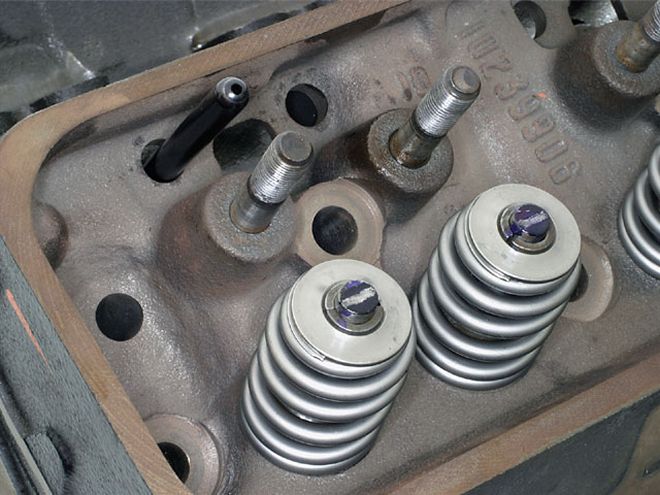 Comp Cams' beehive spring (PN 26918) and retainer (steel PN 787) on our set of Vortecs provided 0.565-inch intake and 0.515-inch exhaust retainer-to-seal clearance-sufficient for the largest cam tested. Pushrod length was chosen to keep the rocker tip centered over the middle third of the valve stem tip throughout the cam's cycle (note contact pattern).
Comp Cams' beehive spring (PN 26918) and retainer (steel PN 787) on our set of Vortecs provided 0.565-inch intake and 0.515-inch exhaust retainer-to-seal clearance-sufficient for the largest cam tested. Pushrod length was chosen to keep the rocker tip centered over the middle third of the valve stem tip throughout the cam's cycle (note contact pattern).
In terms of static comp-ression ratio, generally an aluminum head can tolerate about 1-1.5 points higher static compression than iron heads, so there's some variability here-but the bottom line is if the engine cranks too low, consider either raising the static compression or installing a milder cam. If the engine cranks too high and you have detonation problems, consider a bigger cam with more overlap.
1. Xtreme Energy XE268H-10
Until the advent of Thumpr cams, Comp's Xtreme Energy dual-pattern profiles were the last word in street cams. Typically, Xtreme Energy lobes have 4-10-degree-smaller seat durations and higher 0.050- and 0.200-inch open durations than competitive products. When first introduced, Xtreme Energy cams were worth 10-15 hp over the previous generation. You could go up 7-10 degrees in 0.050 duration over older single-pattern cams yet still retain vacuum and driveability. So, while in theory the XE268 replaces the High Energy 268H, in terms of driveability it acts more like a High Energy 262H. In other words, you get more throttle response plus more power.
Comp bills the XE268H as having a 1,600-5,800-rpm operating range, compared with the 268H High Energy's 1,500-5,500-rpm range. The XE268H should work with a stock converter but is better with at least a 2,000-rpm stall-speed converter. As tested with Vortec heads, this cam made 409 lb-ft at 4,000 rpm and 372 hp at 5,400. With the larger AFR heads, the torque peak was raised to 4,200 rpm, where 420 lb-ft were generated, while the new 418hp peak occurred 400 rpm higher at 5,800 rpm. The AFR heads were worth about 45 hp and 12 lb-ft with the same cam, a trend we would see with all the cams.
With more than 15 inches of vacuum and 175-180-psi cranking compression with either head, this setup is optimal for an entry-level, 10:1, 355ci small-block Chevy.
2. Magnum 280H-10
The second most popular cam, Comp's Magnum 280H, is a carryover second-generation single-pattern profile. Overall, these cams share a similar philosophy to the first-generation High Energy series but with more duration and lift. They are more of a street/strip grind, as opposed to the more street-oriented intent of the original High Energy cams.
According to Comp, this hydraulic flat-tappet cam has a 2,200-6,200-rpm operating range. It requires at least a 2,500-stall converter, headers, and 3.70:1-or-steeper rear gears. Not unexpectedly with the Vortec heads, the 280H Magnum cam was down in torque and power below 4,900 rpm compared with the XE268H. But in terms of overall average output, the two cams were within one number of each other.
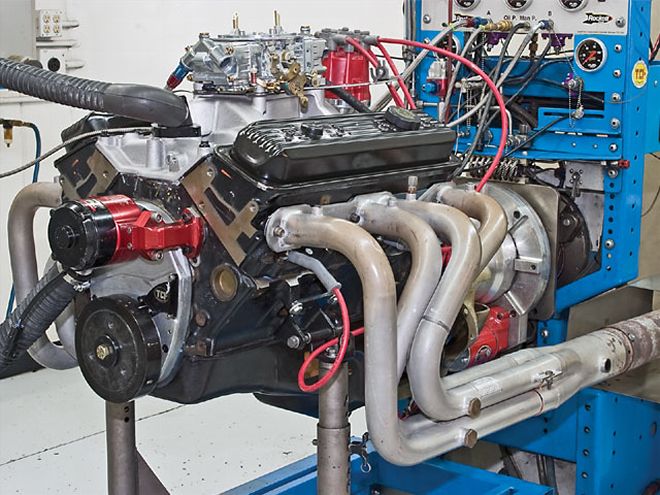 Westech's Gladiator test mule is basically a blueprinted ZZ4 crate motor short-block upgraded with forged pistons. It has more than 600 pulls but still runs like a Swiss watch. The headers are a Hedman Hustler Sprint Car set with 13/4-inch primaries into 3-inch collectors.
Westech's Gladiator test mule is basically a blueprinted ZZ4 crate motor short-block upgraded with forged pistons. It has more than 600 pulls but still runs like a Swiss watch. The headers are a Hedman Hustler Sprint Car set with 13/4-inch primaries into 3-inch collectors.
Mating the larger AFR heads with the larger Magnum cam was worth 48 hp and 20 lb-ft. The AFR heads were stronger throughout the entire rpm range with this cam, which also considerably broadened the overall usable power curve.
Cranking compression was still right in the sweet spot-between 173 psi for the AFR heads and 172 psi for the Vortecs-but vacuum dropped to 13.4 (Vortec) and 12.5 inches (AFR). That's the low end of streetability without auxiliary vacuum augmentation.
3. Xtreme Energy XE274H-10
Comp's third most popular small-block Chevy grind, in many instances the XE274H-10 can replace both the High Energy 268H or even the Magnum 280H. Comp says it should perform from 1,800 to 6,000 rpm, delivering "very strong midrange torque and throttle response." It does need at least a 2,300-stall converter.
In these tests, the XE274H outperformed both previous cams, delivering both higher peak values as well as more total area under the curve on both the bottom and top end. With the Vortec heads, torque production was more than 400 lb-ft from 3,600 to 4,700 rpm. It generated more than 350 hp from 4,500 to 6,500 rpm. With the AFR heads, this cam's advantage only increased, with 433 peak horsepower on tap at 5,900 rpm and 426 lb-ft at 4,300. More than 400 lb-ft was generated from 3,500 to 5,400 rpm and more than 350 hp from 4,400 rpm on up.
Idle vacuum was adequate. With the Vortec heads, the engine cranked at a very healthy 205 psi but only 175 psi with the AFR heads. This was the highest recorded discrepancy for cranking compression between the two heads. At this time we have no firm theory what caused this . . . but what we got is what we got.
4. Magnum 292H-10
The 292H-10 Magnum cam is a healthy cam in the average small-block and borders right on the ragged edge of streetability. We're talking 0.508-inch valve lift and 244 degrees at 0.050, so it's no surprise that Comp recommends 3,000-rpm stall-speed converters, headers, gears, and at least 9.5:1 compression for its street/strip special.
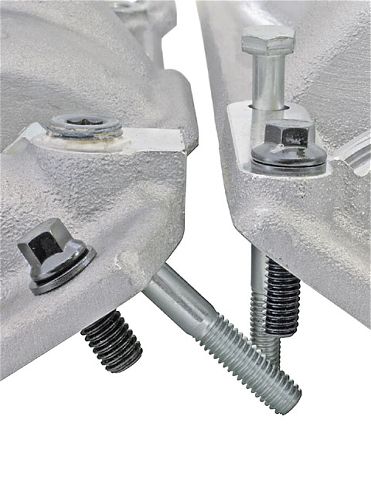 Weiand's 8501 intake for standard heads uses 12 angled 3/8-inch bolts (left, use ARP PN 134-2001). The Weiand 8502 for '96-and-up Vortec heads uses eight vertical 5/16-inch bolts (right, ARP PN 134-2002). GM '87-'95 iron non-Vortec heads have yet another bolt pattern; so far there's no Stealth for them.
Weiand's 8501 intake for standard heads uses 12 angled 3/8-inch bolts (left, use ARP PN 134-2001). The Weiand 8502 for '96-and-up Vortec heads uses eight vertical 5/16-inch bolts (right, ARP PN 134-2002). GM '87-'95 iron non-Vortec heads have yet another bolt pattern; so far there's no Stealth for them.
5. Thumpr 283THR-107 Hydraulic Roller
Comp's series of Thumpr cams has been around just over a year, and one member-the 283THR-107-already ranks No. 5 in sales. Thumprs have made just about everything we thought we knew about streetable cam grinds obsolete. Not bad for a concept gestated from seven years of Comp customer surveys that showed what Joe Hotrodder really wanted in a street cam: First and foremost, it had to sound good; second, be fun to drive; and, almost as an afterthought, also make a lot of power.
Comp Cams lobe designer Billy Godbold is a hard-core engineer who just hated the thought of stepping backward and making a cam that sounded radical but ended up decreasing overall performance. He knew that Comp's series of successful nitrous oxide drag racing profiles had an early-opening exhaust that sounded really good. From its experience grinding 24-hour endurance road-racing cams, Comp had also found that about 20 degrees more exhaust duration permitted running a smaller intake lobe for low-end torque but still let the cam carry well upstairs. And these grinds had to run all day and not break any parts.
Street heads don't flow like race-prepped heads do, but assuming a milder 70-75 percent exhaust/intake flow ratio, Comp determined that street cams and heads like about 14 degrees more exhaust duration compared with the intake. Tightening up the lobe separation to 107 degrees and putting the intake centerline in 5 degrees advanced at 102 degrees ensured low-end response, while the early-opening exhaust kept things working upstairs.
With the Vortec heads, the torque and low end went away in return for top-end power gains, a trend that was accentuated even more with the AFR heads as they peaked at 457 hp, the highest output in these tests. Peak to peak, the AFR heads were worth 57.5 hp and nearly 12 lb-ft over the same cam with the Vortec heads. Compared with the previous XE274H-10 cam, with the AFR heads the 280H-10 gained 25 hp but lost 7.6 lb-ft at the peaks. The 292H-10 cranked between 160 and 165 psi and only had 9.2 inches (Vortec) and 7.9 inches (AFR) of vacuum. You'll have no detonation worries, but forget about power brakes without auxiliary vacuum augmentation.
As tested, this cam beat all the other test cams with both heads in every category but the absolute power peak. The Thumpr made the highest peak torque, the highest average torque, the highest overall average power, the best average numbers between 2,500 and 4,500 rpm, and the best numbers from 4,500 to 6,500 rpm. It made 396 hp at 5,900 and 418 lb-ft at 4,200 with the Vortec heads. Bolting on the AFR heads added 57 hp and 18 lb-ft at the peaks over the Vortecs, the engine now making 453 hp at 6,200 and 435 lb-ft at 4,300. It made more than 350 hp starting at 4,300 rpm, more than 400 hp starting at 4,900, and more than 450 hp from 6,100 to 6,400 rpm.
The Thumpr cranked at 198 psi, and we saw 10.8 in-hg of vacuum with the Vortec heads and 12.4 with the AFR heads. That's better than the 292H, but you'll need a vacuum canister with the Vortecs. The one downside is that this cam's tight 107-degree lobe separation precludes using it with closed-loop EFI systems.
Recommendations
All of these cams should work well in their niches with the proper parts combination. Interestingly, the observed overall performance with Comp's five most popular small-block Chevy cams-as measured by total average torque and power production or area under the curve-increased in inverse order to their sales: The best overall performer was Comp's Thumpr, thanks to the roller cam's quicker opening rate combined with the revolutionary (for the street) intake/exhaust lobe combination. Compared with the flat-tappet cams, it was like dropping a greyhound among a bunch of cocker spaniels. The Thumpr is the cam we'd really like to have, but of course hydraulic rollers in a retrofit application add considerable bucks. The good news is that Comp has Thumpr flat tappets in the works.
Among the flat tappets, the Xtreme 274H is the best overall cam with our basic combination. As for the 292H, it remains a great old-school street/strip cam, but you'd probably need to go up about a point in static compression to even have a prayer of living with it in a daily driver.
Bolting on the AFR heads in place of the Vortecs was worth between 45 and 57 hp, with the highest gains running the two largest cams, the 292H Magnum and the Thumpr. At 6,500, the falloff with the AFR heads is very gradual, making either cam a dynamite choice for a high-shifting street/strip car. Compared with the Vortecs, at 6,500 rpm the AFRs were up as much as 70 hp. Assuming the car is geared to shift about 500 rpm over the power peak, this top-end advantage should translate into a definite quarter-mile e.t. reduction.